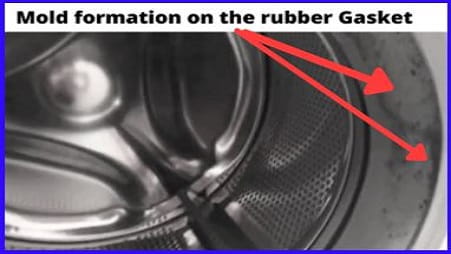Believe it or not, Mold formation is one of the most common problems in any type of washing machine. Whether it’s a Top-loader or Front-loader there is no exception.
Mold and bacteria not only survive but thrives in your washer if you don’t maintain good hygiene.
The formation of mold and bacteria in your washer not only leads to performance degradation but also makes your clothes appear dull. Furthermore, a bad odor starts to develop when wet clothes are left in the washing machine for a little longer.
If that’s not enough, excess mold and bacteria can also lead to allergies and skin rashes if it goes unaddressed.
While it may sound scary, there is always a solution.
In this guide, you will learn about:
- What Is Mold?
- How Mold is formed?
- How to get rid of Mold?
- Best practices to keep mold and bacteria away
- And more…
Let’s get started…
Table of Contents
What is Mold?
Molds are a group of fungi that thrives in wet, humid, and damp conditions. Almost all types of washers will have a wet and damp condition, as it deals with water and detergent residues every day.
There are mainly, two types of mold:
Indoor: The one that grows in carpets, fabrics, washing machines, bathtubs, and so on. Indoor Molds are problematic and may cause mild allergies.
Outdoor: The one that grows outside and is needed by the environment to break down animal matter.
Indoor or Outdoor molds cannot be differentiated with naked eyes, therefore whenever you see clusters of black spots, always clean them.
While mold can develop in any type of washing machine, it’s more common in high-efficiency front loaders. This is primarily because the rubber gasket prevents leakage by sealing the door from inside in a frontload washing machine.
Excess mold can certainly be risky as it can trigger allergies, itching, sneezing, coughing, asthma, sore throat, skin rash, and sometimes eye irritation as well (1).
Now that you know what mold is, let’s take a quick look at how it is formed and how to get rid of it.
READ: Is it Necessary to have a washing machine stand?
How do you know if your washing machine has mold?
One of the most common symptoms of mold formation is the smell.
The moment your washer or laundry room starts to smell like sulfur or old socks, it is a good indication that mold exists.
While the smell may differ, any stale smell that you notice without any obvious reason can also be a good indicator.
Lastly, if you notice clusters of dark spots in any inside part of your washing machine, it is a clear indication that it’s heavily infested with molds and bacteria, and needs urgent attention.
Always, look for spots or clustered growths in the inside part of your washing machine.
Here are some telltale signs that your machine may be harboring mold:
Unpleasant Odors
One of the most noticeable signs is an unpleasant odor emanating from your machine. This smell is often musty and can transfer to your clothes, making them less than fresh even after a wash.
Visible Mold in Crevices
If you see black or green spots in the rubber seal, detergent drawer, or around the drum, you likely have a mold issue. These visible signs are a clear indicator that immediate cleaning is necessary.
Damp, Earthy Smell Coming from the Machine
A damp, earthy smell is another red flag.
This odor is characteristic of mold and mildew and indicates that spores are present in moist areas of the machine.
Being aware of these signs can help you take immediate action, ensuring that your washing machine remains a clean, hygienic, and efficient appliance.
READ: How to clean a portable washing machine?
How does Mold develop in Washing machines?
Molds in the washing machine are caused mainly due to detergent residues and moisture trapped around the Rubber seal. A wet, damp, and dark environment along with dirt, bacteria, detergent, and fabric softener residues make a perfect recipe for Molds to thrive.
Very often, you will notice clusters of black or green patches on the rubber seals and different internal parts of your washer.

Causes of Mold Growth in Washing Machines
Understanding the root causes of mold growth in your washing machine is the first step in effective mold removal.
Here are some of the primary conditions that make washing machines a breeding ground for mold:
High Humidity
Washing machines operate in a moist environment, making them susceptible to humidity. High levels of moisture create the perfect conditions for mold and mildew to thrive.
Poor Ventilation
Lack of proper ventilation can trap moisture inside the machine, contributing to mold growth. Machines placed in small, enclosed spaces are particularly at risk.
Residual Detergent and Fabric Softener
Leftover detergent and fabric softener can create a film that traps moisture and provides a fertile ground for mold.
Overloading the Machine
An overloaded machine restricts airflow, creating pockets of moisture where mold can grow.
Not Running the Machine Regularly
Infrequent use of your washing machine can lead to stagnant water and, consequently, mold growth.
Additional Causes
- Water Damage: Leaks or spills can contribute to mold.
- Condensation: Trapped warm air can lead to condensation, another contributor to mold.
- Dampness: Leaving wet clothes in the machine for an extended period encourages mold.
- Inadequate Cleaning: Failing to regularly clean the washing machine can lead to mold buildup over time.
Now that you know what a mold is? And how does it develop in your washer? Let’s take a quick look at the tools required to get rid of it.
READ: How to use a portable washing machine effectively
What you will need to clean the mold?
There are multiple ways to get rid of the Mold from your washing machine.
One way to eliminate mold completely is to use cleaners or solutions with sprays available at online stores or at a local shop.
The other way to do it is by using proven home remedies.
For cleaning mold using home remedies you will need the below items:
- Hydrogen Peroxide (Only for excess molds)
- Lemon Juice
- Distilled White Vinegar
- Bleach (Only for excess molds)
- Water
- A Pair of Gloves
- An old towel
- A cloth
READ: How to Troubleshoot a Portable Washing Machine?
Precautions Before Starting
Before you dive into cleaning the washing machine, it’s crucial to take some safety precautions:
Safety Gear
Always wear protective gloves and safety glasses to protect yourself from mold spores and cleaning agents.
Preparing the Machine
- Empty the washing machine: Make sure there are no clothes or other items in the drum.
- Disconnect from Power: Unplug the machine to ensure there’s no risk of electrical shock.
Steps to clean mold from washing machine
Step 1: Start by wearing protective gloves.
Step 2: Prepare the solution by either mixing the hot water with Bleach OR Vinegar OR Hydrogen Peroxide.
Note: Never mix Hydrogen Peroxide with Bleach OR Vinegar as it can be toxic. Also, it’s not recommended to mix bleach with vinegar as it may be harmful.
Step 3: Dip the cloth in the solution and start scrubbing the mold-infested areas.
Step 4: Ensure you clean the detergent and fabric dispensers as well.
Step 5: Now Pour the Vinegar into the detergent and Fabric softener dispenser and run the hottest washing cycle.
Step 6: After the washing cycle gets completed, take an old towel and wipe away all the moisture. Also, make sure you wipe the detergent dispensers as well.
Step 7: Clean the Lint filters
Step 8: Keep the door open for some time for air circulation.
READ: Top Load VS Front Detergents
Steps to clean mold from rubber seals
Just grab a spray bottle and use any of the below mixtures:
- Water and Distilled White Vinegar – Take ¼ cup of distilled White Vinegar and half a cup of water, mix it thoroughly, and put it in a spray bottle. Now spray this solution on mold-infested areas.
Note: This remedy is applicable only in the initial stages and may not work well if there is excess mold formation. - Hydrogen Peroxide with Lemon Juice – If the mold formation is in excess, try using a Hydrogen Peroxide mixture along with water and lemon. This solution not only eliminates mold but also stops growth. If you are using 1 cup of water, then try to keep the Hydrogen Peroxide and Lemon juice content to ¼ cup each.
- Bleach Solution – The last and the best solution to get rid of heavily infested mold areas is to use bleach. Simply take ¼ cup bleach and half a cup water, mix it thoroughly, and pour this solution into the mold-infested areas. This solution is proven to work and will surely keep molds and bacteria away for a long time.
READ: How to wash a down jacket in the washing machine?
Types of Washing Machines Most Susceptible to Mold Growth
Not all washing machines are created equal when it comes to the risk of mold growth. Here are some types of washing machines that are more prone to mold issues:
Front-Loading Machines
Front-loading washing machines are particularly susceptible to mold. The rubber seal around the door is a hotspot for moisture accumulation, making it a breeding ground for mold and mildew.
Top-Loading Machines with Agitators
While top-loading machines are generally less prone to mold, those with agitators can still harbor mold in the crevices around the agitator and drum.
Machines with Poor Drainage
Any machine that doesn’t drain properly is at risk, as standing water is a primary cause of mold.
Machines Lacking a ‘Clean Cycle’ Feature
Washing machines without a self-cleaning or sanitizing cycle are less equipped to combat mold growth, requiring more manual intervention to clean the washing machine.
Also, certain older washing machine brands may lack modern mold prevention features like a sanitizing cycle, making them more susceptible to mold growth.
Being aware of the types of machines that are more susceptible can guide you in making an informed purchase or taking extra precautions for mold prevention.
Tips to prevent the build-up of mold
It’s always a wise idea to take proactive steps to try and stop the formation of the mold rather than being reactive.
Taking proactive measures will not only keep your clothes happy but also prevent health issues associated with mold.
Here are a few tips to keep the build-up of mold in check.
- The very first tip is to keep an eye on your washing machine after every three to four rounds of usage.
- Always let the moisture escape, and leave the washing machine door open after every wash for a while.
- Make sure you remove the wet clothes immediately after every wash, as it also helps to reduce the pressure from the drum’s suspension.
- Do not allow any dirt to gather in the washing machine, especially in the Rubber Gasket and other corners.
- Use good quality detergent and suitable fabric cleaners.
- Keep cleaning the washtub whenever required.
- Do not miss the timely servicing done by experts.
- Try to avoid Fabric softeners if possible.
- Clean the dispenser system at least once a week.
- Periodically clean the Lint filter.
- Keep the humidity level low, if possible use dehumidifiers.
READ: What is RPM in Washing Machine?
Final Thoughts
Always keep your washing machine clean and try to stay away from cheap detergents that leave large amounts of residue behind. These residues tend to build up over time, thereby promoting the growth of mold and bacteria.
Molds and bacteria pose a health risk and should be addressed as soon as it gets detected.
Lastly, Whenever possible try to dry the inside part of the washer if there is a frequent build-up of mold.





